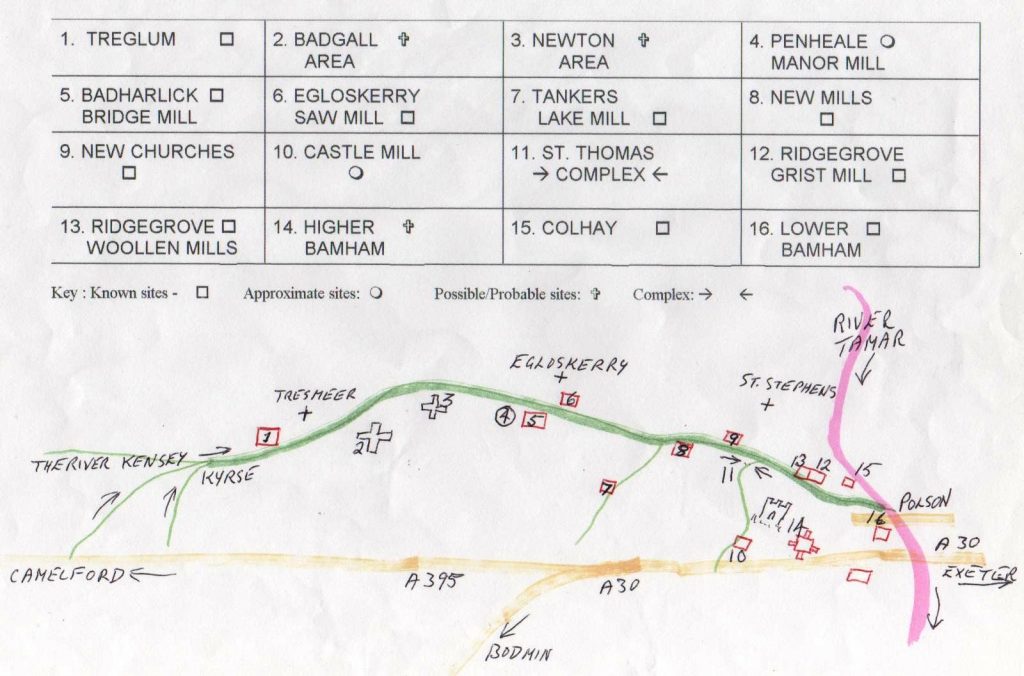.

Of the only six mills in Cornwall in the Domesday Records, two are ‘in Launceston’. Those two mills are Treglum, below Kyrse in Tresmeer parish, and Ridgegrove, below Launceston – both belonged to St Stephens Priory before 1066. Ridgegrove traced to the time of Athelstan – approx. 1080 years.
Town Mills, although diverted for a time to other uses, points in its name to some antiquity and importance, while Ridgegrove Mill figures as Riggrove Mylle in the ancient Priory Pent Polls. In the 1830s there spinning jenny manufactures at New Mills, Town Mills, Ridgegrove, Wooda Road, and the island at St. Thomas bridge, these hives of industry employing hundreds of people, and paying wages at the rate of £250 per month or £3,000 per year, the greater part of which found its way into the tills of our shopkeepers, and adult females and girls and boys of eight years of age could then earn their own living. There was also a good trade with Bude and Boscastle, waggons plying to and from every day ; and we had further a large flour business carried on by Mr Bailey at Ridgegrove, Mr Uglow at Town Mills, and Mr Jury at Yeolmbridge, it being supposed that these three sent to Plymouth upwards of two hundred sacks of flour weekly. As far back as 1774 an Act had been passed “for making a canal from Bude to the River Tamar in Calstock parish,” which would have affected this district, and a scheme was put forward twenty-one years later “for making a navigation from Morwelham Quay in Tavistock parish to Tamerton-brio go in Cornwall, and also a collateral cut from Poulston-bridge in Lifton parish, Devon, to Richgrove (sic) Mill in St. Stephen’s parish, Cornwall. Both schemes failed but as the result of an Act of 1819 there was constructed the Bude Canal, terminating at Druxton Wharf, four miles from Launceston (being prevented from being brought nearer the town by the influence of the Duke of Northumberland), this being for many years the chief coal-carrying agency of the district.
Treglum Mill was a mill house and corn mill built around 1750 and is now listed with English Heritage.
Priory Records No.214: Confirmation by John Burgh de Borlandre of the estate of Prior Roger and the convent in the weir and milldam in Kyrse (Keuros) which is to their mill of Treglum and which they released to John without payment. John Helygan, Stephen Bodulget, Nicholas Bokelly and Stephen Grant.
Launceston, 7th. January 1411.
Records of Launceston Priory: Cartularies.
No.251. Gift by Robert son of William to the priory for the soul of Countess Mabel and for the souls of the mother and father and their parents. 20s. of rent, i.e. from the land of Tregeare and from the mill of Castle Milford. Witnessed by Earl Reginald, Richard, Earl of Devon, Roger de Valletorta, Robert de Dunstanville, William de Botrell. (circa. 1155-62 – the lifetime of Richard de Reviers, 2nd earl of Devon).
No.252. Gift by Robert son of William to the priory of rents of 20s. for the soul of his sister, the Countess Mabel, i.e. the land of North Tregeare with Alwin, the forester, and his progeny by his former wife for 10s. and the mill and all mulcture of the manor of Downinney. Witnessed by Earl Reginald, Earl Richard de Ridvers, Roger de Vallatorte, William de Botrell, Walter abbot of Tavistock, John and Roger, chaplains, Bernard notary public, William, sheriff, circa.1155-62]
No.213: Obligation by Benedict Reynward not to call the prior of Launceston nor his successors to warranty by reason of his homage for the land of the priory in the vill of Treglomma (Treglum) in the parish of Tresmur (Tresmeer) and he would grant warranty by reason of his homage contra omnes homines mortales.
Dated Launceston Thursday 18 December 1287.
No.214. Confirmation by John Burgh de Barlandu of the estate of Prior Roger and the convent in the weir and mill-dam in Keuros (Kyrse) which ran to their mill of Treglum and which they had released to John without payment. Launceston 7 January 1411.
215. Release by John Burgh de Barlandu to Prior Roger and the convent of his right in the mill-dam and weir of Treglum in Kyrse. Launceston 7 January 1411.
217: Final concord between Prior William and the convent of the one part and William de Keuros and his heirs of the other part about the former litigation and controversy between them concerning the waste of a certain amount between the ford of Bodgalla (Badgall) and Kyrse. That is to say from the western side of the stream which came down from the well called Suetewill (Sweetwell) and then as far as the stream which came down from Kyrse. Thence to the stream which came down from the hollow ditch on the eastern part of Blakemor in the stream of Kyrse just as it went above the turbary as far as above the ploughland called Serpewns and from the ditch to the two grey stones and thence to the ford of Riddellon. Both parties granted that the land should be equally divided between them, measured by small acres by the perch by the view of legal men. The prior and convent quitclaimed Walter de Keuros and his heirs of the right he said he had by the king’s writ in the vill of Kyrse. They could not exact from Walter and his heirs any right in the vill of Kyrse except suit which he owed to the free manor of Launceston. It was also agreed that the prior and his men had common pasture through the whole waste without any molestation from William or his heirs or his men forever. Meadow and turbary in the waste were to be equally divided between both parties without contradiction. (Between 28 October 1232 and 27 October 1233.)
Visits: 356
